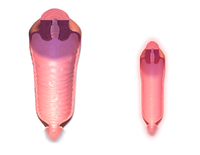
Photo from wikipedia
BACKGROUND We analysed contemporary pelvic lymph node dissection (PLND) trend during radical cystectomy (RC) for urothelial carcinoma of urinary bladder (UCUB), as well as PLND association with cancer specific mortality… Click to show full abstract
BACKGROUND We analysed contemporary pelvic lymph node dissection (PLND) trend during radical cystectomy (RC) for urothelial carcinoma of urinary bladder (UCUB), as well as PLND association with cancer specific mortality (CSM) and complications after stratification according to octogenarian vs. younger age. MATERIALS AND METHODS Within the SEER and NIS databases, respectively 10,427 (T2 and T3 stages) and 19,203 (all T-stages) RC patients (2004-2015) for UCUB were identified. Univariable and multivariable analyses focused on PLND rates, CSM after inverse probability of treatment weighting (IPTW) adjustment, complication rates, length of stay (LOS) and total hospital charge (THC). RESULTS Within the SEER database, RC and PLND was performed in 9,406 patients (87.4%), 981 (10.4%) octogenarians and 8,227 younger patients (at, respectively, 83 and 89% PLND). PLND rates increased over time in both patients groups (p < 0.05). PLND was independently associated with lower CSM in both age groups (octogenarians: hazard ratio [HR] 0.51, p < 0.001; younger patients: HR 0.56, p < 0.001). Within the NIS database, PLND was marginally higher associated with overall complications in octogenarians than in younger patients (odd ratio [OR]: 1.32 vs. 1.23, both p < 0.001), with longer LOS (OR: 1.20 vs. 1.08, both p < 0.001), higher THC (relative increase: 6933 vs. 4484, both p < 0.001), but not with higher in-hospital mortality. CONCLUSIONS PLND is associated with lower CSM, but its rate lags in octogenarian vs. younger patients. In both age groups, PLND leads to marginally higher complications, longer LOS and higher THC, but not to higher in-hospital mortality.
Journal Title: Cancer epidemiology
Year Published: 2019
Link to full text (if available)
Share on Social Media: Sign Up to like & get
recommendations!